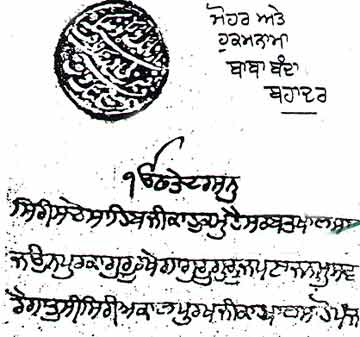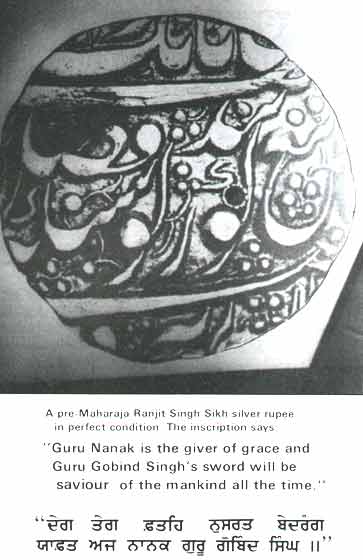
There is a thick
cloud of differing opinions about Sikh Coinage. Some that are in very
high favour of their authenticity while others portray them fake or copies
of many existing mint-oriented traditions. The originality and uniqueness
of the Sikh Coins has been ruthlessly damaged in the scholarly numismatic
world. Our observation and brief study is based on published material,
on the subject, during the last two centuries. We don't hesitate to accept
the shortcoming of our own postulates presented some thirty years ago.
We don't claim to put the final word but certainly we initiate a much
sought after issue to a wider audience. Pantopotamia - the land
of five rivers was well known in the ancient times for her arts, culture
and highly advanced civilization. As early as the 4th century BC the historians
of Greek invader Alexander found gold, silver and copper coins of the
Panchal Desh (Punjab). The tradition goes back to the times immemorial
during the Harrapan Age when this region was known as Arya Varat or Sapt
Sidhu by the sages of Vedic period. The Punch Mark coins are undated but
the Alexanderian coins of the Punjab are the oldest dated coins in our
collection.We have an evidence of King Samant Dev's Punjab Coins, which
were accepted in India and Western Asia up to old Iran, as legal tender.
The value of Punjab coins in the antique numismatic market is growing
rapidly but the unbiased and systematic study is in oblivion.
The Term 'Taxaal'
The Taxaal (Mint),
a metaphysical term first appeared in the first Divine Hymn Japji Sahib
of the Sikh Scriptures. In the last stanza it says:
"GVIey sbid scI tkswl ]
ijn kau ndr krn iqn kwr ]
nwnk ndrI ndr inhwl ]"
"The true word would be minted in the Divine Mint.
Those who are blessed they are bestowed with His sublime and benign favour.
Nanak says, it is only the blissful grace of the Creator that saves human
soul."The term Taxaal has created an unending controversy and confusion
in the study of Sikh numismatics. It is established that Taxaal is a school;
of thought, which deals with interpretation/practice of Sikh Scriptures.
The first such Taxal was established by Guru Gobind Singh himself who
appointed Bhai Mani Singh as the head-granthi of Sri Darbar Sahib, Amritsar.
This Taxal developed into the "Damdami Taxaal" and eventually
the term Taxal has assumed the connotation of a school of thought rather
than a Mint where metal currency is manufactured.There are two coin Taxaals
in Sikh history. i. The Nanakshahi Taxal. ii. The Gobindshahi Taxaal.
Although Guru Hargobind Sahib established the first ever Nanakshahi Taxaal
during his Guruship, along with the Miri and Piri concept at the Akal
Bunga but the product of this mint was confined to Dargahi Tokens and
they never gained currency as legal tender. We have collected a lot of
these Dargahi Tokens, which are made available to the inquisitive researchers.
was revitalized from
Madho Das Bairagi to a conscientious warrior by Amrit Sanchar. The Master
sent him to Punjab with symbolic five arrows. He re-organised the scattered
Sikh bands and smashed and annihilated the callous regime of oppressors.
He established his final capital at Mukhlispur (near Ambala) and wiped
out the Mughal atrocities - ridden phenomenon. At the capital he incepted
the Gobindshahi Taxal. The popular legend of 'Degh Tegh Fateh' was created
and used by this mint for the first time. It says,
"Degh Tegh Fateh Nisrat Bedrang,
Yaft Az Nanak Guru Gobind Singh "
"Abundance, Power and Victory (and) provisional assistance without
delay
are the gifts of Nanak (and) Guru Gobind Singh."This legend is duly
preserved in the seal of this capital in Persian. It is written in such
a way that the reader would start reading from bottom to top rather than
top to bottom. We have procured the original seal. The coins bearing this
legend are still very rare. A private collector S. Saran Singh of Malaysia
is the only one individual in the world who got some of these coins. This
legend was never inscribed in Gurmukhi script on any coin by any one.
The Panjabi version in Gurmukhi script was used by Mata Sundri Ji in Delhi
after the demise of Guru Gobind Singh in 1708 AD. We have in our collection
this original seal also.

A new Mint, 'Zarb' came into being. It was called,
"Zarb Rakab Bakhat"
"The Mint on Horse-back."
The Nanakshahi couplet was first used in the mint:-
"Sikka Zad Bar Seem O Zar
Fazl Sacha Sahib Ast.
Fateh-I-Gobind Singh-I-Shahan
Tegh-I-Nanak Wahib Ast."
"Coin struck in silver and gold by the grace of the true Lord.
Of the victory of Gobind Singh, Lion of Kings,
Nanak's sword is the provider."
There are, however, many variations in these legends, which partly appear in the coins struck at various mints of Sher-e-Punjab, Maharaja Ranjit Singh. These mints were based in eight places: Amritsar, Lahore, Anandgarh, Derajat, Multan, Peshawar, Kashmir and Jammu. All silver coins bear the Nanakshahi year. Guru Nanak Dev was born in 1469 AD. i.e 1526 Bikrami. Sher-e-Punjab Coronation took place in 1801 AD or 1858 B. So his coronation coins bear year 332 Nanakshahi. The gold coins were Double Mohar, One Mohar and Half Mohar. The silver, one rupee, half rupee, one-fourth rupee and the copper, one Anna, half Anna, Paisa, half Paisa and Dhela. All Sikh Coins have a mintmark of 'Leaf' with ten variations.
Some coins bear a very special of Lions, Kataars, Lotus and Flags. On top of coins and tokens there existed lot of Sikh Medals issued during Misls and Sher-e-Punjab regime (to be discussed in another article entitled Sikh -Decorative Titles).



